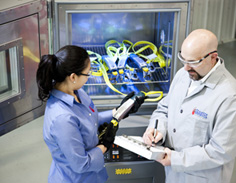A Change for The Better: Accurate testing of fall protection products
 The accuracy and repeatability of test results for fall protection equipment has always been in question. Fundamental problems, such as liberties taken with the interpretations of standards, limited conformity of testing apparatuses between laboratories, unknown testing uncertainties, and non-calibrated measuring equipment, etc., have led to inconsistent results between laboratories. Without a benchmark, the ability to trace the source of a discrepancy has also been difficult. Each lab believes their test data is correct. Combine this with the fact most labs are created and maintained by the manufacturer of the final product, and you’ve got a potential recipe for disaster.
The accuracy and repeatability of test results for fall protection equipment has always been in question. Fundamental problems, such as liberties taken with the interpretations of standards, limited conformity of testing apparatuses between laboratories, unknown testing uncertainties, and non-calibrated measuring equipment, etc., have led to inconsistent results between laboratories. Without a benchmark, the ability to trace the source of a discrepancy has also been difficult. Each lab believes their test data is correct. Combine this with the fact most labs are created and maintained by the manufacturer of the final product, and you’ve got a potential recipe for disaster.
Many design assumptions are based on the results of initial product testing and, therefore, a final product’s function can hinge on this information. To start the design process or verify equipment strength and functionality with incorrect, corrupt, or unsubstantiated data can easily result in an end product that’s based on a flawed initial premise. Reaction to this knowledge will lay the foundation for the design of future fall protection equipment.
To combat these issues, the ASSE /ANSI Z359 Accredited Standards Committee has established the ASSE/ANSI Z359.7 “Qualification and Verification Testing of Fall Protection Products” standard. This new American National Standard has recently been balloted and approved, and will likely be released in the fall. Once published, manufacturers will have a one-year implementation period to comply with the standard.
Equipment manufacturers
So, what does the new standard mean for fall protection equipment manufacturers? For the first time, manufacturers using the ANSI Z359 marking on their fall protection equipment will have to verify their testing results meet the individual standard the product is supposed to conform to. Manufacturers will have to follow strict testing guidelines, which will require them to either have an in-house ISO accredited laboratory or use a third-party ISO accredited laboratory to perform the qualification and verification testing of their product.
Becoming an ISO accredited laboratory is no easy task and will help to ensure that each laboratory is using the proper technicians and has a thorough understanding of the testing standards. ISO accredited labs are required to have properly calibrated equipment, to ensure test results are correct, and to calculate the uncertainty of an entire test. The intent and the expected final result is that testing in any lab should be repeatable and consistent anywhere in the United States and, theoretically, throughout the world.
Up until now, laboratory accreditation wasn’t required and consumers of fall protection products relied solely on the scrupulous nature of the manufacturers and their testing practices. Similar to any industry, there are fall protection manufacturers who are extremely responsible and others who are less so. It’s always surprising to find “life-saving” fall protection products that carry the ANSI marking, but don’t actually meet these standards; however, they do exist. The failure to meet testing specifications occurs much more often than one might expect.
In most cases, failure doesn’t automatically indicate an imminent life-threatening concern, as there is usually more than enough strength in a fall protection product from an engineering standpoint. A failure to meet standards could be caused by a number of factors including poor qualification testing on the manufacturer’s part, a change in the product that no one thought would affect the strength, or simply test equipment that isn’t properly calibrated or set up. But, it’s difficult to determine the root of an issue when no one wants to take accountability for the failure, admit there is a problem, or be able to trace the testing history of a product.
The end user
If you’re an end user of fall protection equipment, there will now be a standard that all manufacturers can be measured against, and a method to verify and prove any equipment being purchased has been properly tested. This provides a user with a high level of confidence. If a manufacturer has used the ANSI number on their equipment, they have used an ISO-17025 accredited lab for testing—and there’s verification the equipment has met the applicable standard. End users are encouraged to ask manufacturers for documentation of the testing, which any manufacturer will have to provide. Although the fall protection industry has always been a buyer-beware market, this new testing standard will help to even the playing field, and make the purchasing experience a little less confusing. End users can be confident knowing the equipment they’re using will have been tested in an environment where the results are not only accurate, but can also be verified.
Testing labs
Test laboratories will have to meet more stringent levels of knowledge, procedures, documentation, test equipment calibration, uncertainty measurements, test weight conformity, and more—the list goes on. Proficiency testing procedures have to be implemented at test laboratories so repeatability in test results can be verified, which will help ensure results are similar no matter what laboratory performs the testing. Presently, it’s common to have two labs with different results for the exact same tests on a product. Which lab is correct? Or, are they both wrong? Currently, there’s no way to tell unless both labs meet the same basic operating requirements. Until ASSE/ANSI Z359.7 is implemented, there’s no way to be certain.
Without a commitment that ensures repeatable results, no matter what laboratory is performing the testing, one can never be absolutely sure the basic premise used to develop and test fall protection equipment is correct. However, the new ASSE/ANSI Z359.7 standard will help foster a culture within the fall protection equipment testing laboratories, which allows them to provide information to manufacturers so they can create safer and more reliable equipment.
Gravitec Systems, Inc.
www.gravitec.com
Author: W. David Lough
Volume: July/August 2011










.jpg?r=7267)
